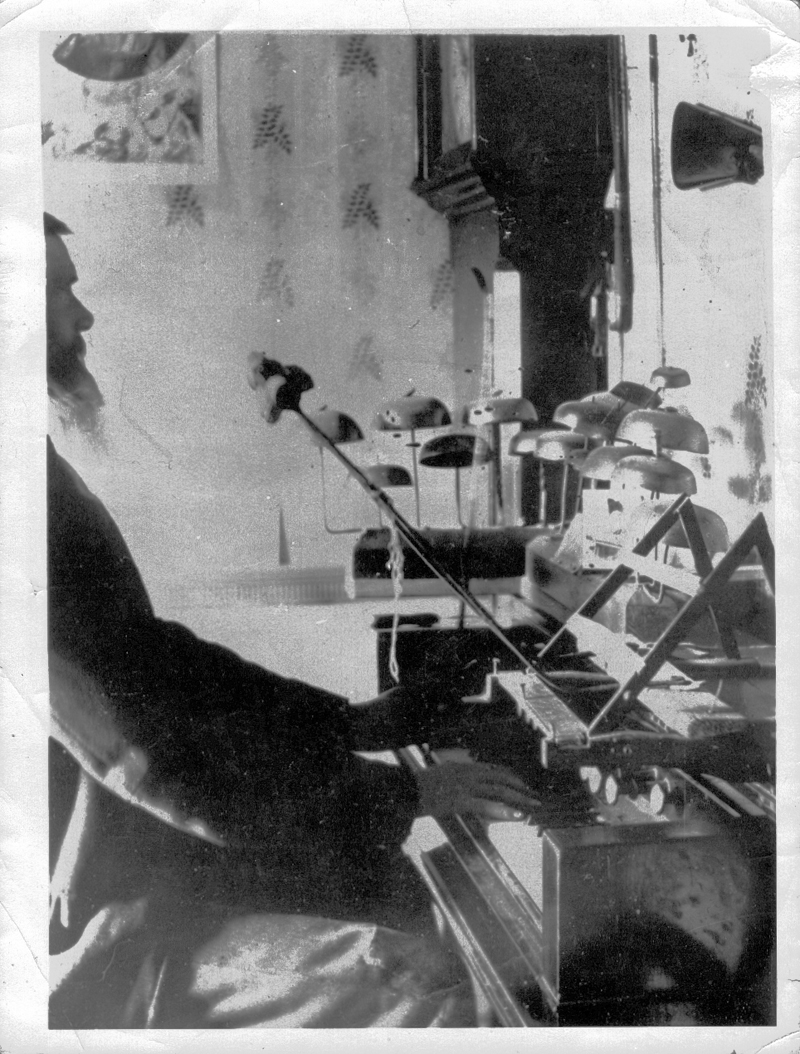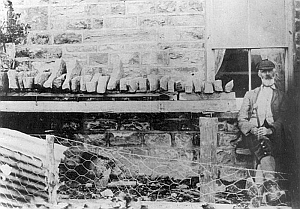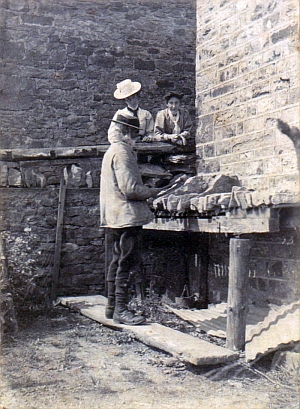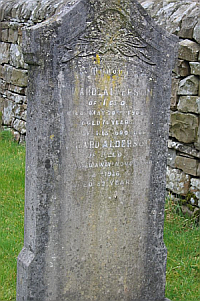| Viewing swaag.org website implies consent to set cookies on your computer. Full details | Swaledale and
Arkengarthdale Archaeology Group Registered Charitable Incorporated Organisation Number 1155775 |
SWAAG Honorary President:
Tim Laurie FSA |
| Neddy Dick
(Richard Alderson of Keld) Ballad of Neddy Dick 2:47 Bob Pegg |
|
| SWAAG member Ric Carter having researched lithophones and their connection with Neddy Dick, a notable upper Swaledale character from the mid 1800's, decided that it may be an interesting subject to both involve the SWAAG membership and the Swaledale community in, and could become part of SWAAG's Swaledale Project and a Swaledale Festival event. Unfortunately the timing was just too late for the 2012 Swaledale Festival. However with the help of many people in particular: Bob Pegg, Christine Amsden, Marion Hearfield and members of the Upper Dale Family History Group we have been able to assemble some facts about Neddy Dick. | |
| Who was Neddy Dick? Neddy Dick's actual name was Richard Alderson. Swaledale is
famous for the number of Alderson families past and present.
When Neddy was born there were several Richard Aldersons and it
is possible that Neddy Dick got his nickname as being Richard (Dick)
the the son of Edward (Ned) Alderson, to differentiate him from all the
other Richard Aldersons. Neddy's parents were Edward and Ann Alderson. They were farming at Greens, near Muker, when Neddy was baptised on November 24th 1845. Neddy died on 2nd November 1926 at at Sunnybrow, Reeth, and is buried with an older brother Edward in Muker churchyard. He seems to have been a real character, a loner with a passion for music. He became locally famous for the limestone lithophone he constructed, using stones mainly taken from the river Swale. Hear more about him from these 2 short audio clips from the 1960's. The first is from a lady in Keld, the second by Laurie Rukin. These 2 recordings were kindly supplied by Bob Pegg: 1 Lady from Keld 2 Laurie Rukin. Now listen to Bob's Ballad of Neddy Dick the words are below: |
Click
Map to Enlarge © Crown copyright and database rights 2011 Ordnance Survey 100023740 by kind permission of YDNPA. |
| Break the jug upon the hearth, the
fiddle on the stone – Neddy left this evening and he won’t be coming home. Remember all the times he came knocking at the door? Neddy left this evening, and he’ll come this way no more. Neddy was a farmer, till he chose the roving way, And weeds crept in his kitchen, and his sheep they ran astray. He climbed the moorland mountains when the weather it was fair, To sit alone, and listen to the music in the air. By the reaches of the river, where otter is the king, Neddy sat upon the bank to hear the waters sing. The music of the stones was ringing in his head; He braved the stream to pull them out from the river’s bed. One winter when he was a lad and snow lay on the fell He learned to play harmonium – the story I will tell. He took the bells from many clocks and hung them from a branch; When he struck up with feet and hands he made our valleys dance. On the day that Neddy died, they took his precious stones – Broke them into little bits and scattered them with his bones. Neddy only smiled and sadly shook his head, “If that’s the best that they can do, I’m far off better dead.” |
 Neddy at his harmonium. Click to Enlarge. In the 1980's, Julie Anne Fullarton and Bob Pegg wrote a play about Neddy Dick called 'Big Bird', which was performed by a Bradford Theatre. |
| The
above photograph is of Neddy
playing his harmonium (or reed organ) in his home. He
holds a stick in his left hand for striking the bells on
top of the instrument. A tube-like device rests on the
harmonium, protruding at an angle which brings it in
line with his mouth. Many
harmonicas made either side of 1900 incorporated bells,
reeds and flutes, and came in many different shapes and sizes.
This tube was Neddy's version. There is a string
attached which might have been used to angle this
flute-like tube into position. Fourteen bells of varying
sizes, mainly from clocks sit on top of the
harmonium. Below is a photograph of Neddy's limestone lithophone, a row of stones many from the River Swale and from local dry-stone walls, which was augmented by a few bells, and could be mounted on a donkey cart which he took on local entertainment tours. As Neddy was a bachelor with no-one to care for his personal effects, after his death the contraption was consigned to an outbuilding and the components subsequently lost. |
|
|
In his “A History of Swaledale” (published: Dalesman Books, 1973) Edmund Cooper wrote: Many of the older generation of dalesmen will
remember Richard Alderson of Keld, commonly known as
“Neddy Dick”. He constructed his own pecular (sic)
percussion instrument, composed of a row of rounded
stones collected from the River Swale, each of which,
when struck with a hammer, gave its own distinctive
note. He was described by a fellow villager: “He wer a
queer un. He wer brought up to farming: but his mind wer
always running on music. He neglected ‘isself badly and
though he had money he didn’t know how to use it. Lots
o’ fowk came to hear him play on t’ stones he had fished
up out o’ t’ beck”
|
 Neddy Dick's limestone lithophone by his cottage in Keld. (Click to enlarge) More information about lithophones |
|
From the archives of the
Alderson Family History Society: This photograph (right) shows one of Swaledale’s most celebrated characters. It is of Neddy Dick Alderson (1845 - 1926) whose fame arose when he discovered that certain stones had a musical ring to them when struck. So he assembled a range of stones to make the full musical scale and would sing when playing them. When he died the stones were neglected and eventually they were thrown back into the Swale! R. A. S. Parents: Edward son of Edward ALDERSON of Greens – he died in 1853 Ann daughter of John ALDERSON of Keld – she died in 1886 Richard (Neddy Dick) died 1926-11-02 at Sunnybrow, Reeth. In Marie Hartley’s book Yorkshire heritage she says: "No visitor to the dale in their day (she didn’t personally know Richard ‘Neddy Dick’) failed to call on Neddy Dick famous for his stone piano made from boulders picked out of the bed of the Swale, and his harmonium with its set of bells collected from clocks up and down the dale. These latter he played with a stick held in his left hand, and while striking the bass note with the butt, he tapped a bell with the other part of the stick, and played a mouth-organ at the same time." Extract from YORKSHIRE VILLAGES by G. Bernard: A KELD CHARACTER: In Keld, they still keep green the memory of Dick Alderson, alias Neddy Dick. Neddy made music from stones! While climbing near Kisdon Force one day, he dislodged a sliver of rock and heard a distinct musical ring as it fell upon another rock. Thus began a search for other tuneful pieces, with the result that eventually he created a full 'limestone scale'. He would sing to the accompaniment of his stones, and sometimes added a few bells for greater effect. He never achieved his ambition to go 'on tour' with this melodic outfit piled into his donkey cart, but he meant more to Swaledale folk than any Kreisler. Alas, after a period of neglect, his 'rock band' died with him. Yet there is still plenty of latent 'music' awaiting discovery amongst the crags and river-stones around Keld! |
Neddy entertaining
in front of Birkshill View, Keld. Date unknown. Click to
enlarge. Image kindly supplied by the: Alderson Family History Society |
| It appears Neddy may have died a lonely death in at Reeth Workhouse (Sunnybrow), which by 1926 was more of a 'hostel' for those that could no longer look after themselves. It closed down in 1930. There doesn't seem to be any records to confirm this. If you have further information to add to this web page please use the contact form. We can then get in touch so you can send any images or documents. The Muker parish registers say Neddy was christened on the 24th November 1845. There are 81 years, 11 months, and 9 days between then and when he died. Neddy's gravestone says that he died aged 82. His actual date of birth is unknown although the birth certificate should be available. | |
|
See the full image here:
http://www.dalesgenealogy.com/MukerChurchyard/edwardalderson.html
|
|
| Neddy Dick's Family
History Neddy's mother Ann was pregnant with Neddy when Ann's previous son, also call Richard, died in May 1845. There was only one Richard Alderson marriage in the Muker parish registers and that was of another Richard Alderson born in Keld in 1937, so Neddy's reported bachelor status appears to be correct. 1901 there was another Richard Alderson in Keld, a 54-year-old farmer who may have been one of the top two entries here.
Dalesgenealogy.com has this list for Neddy: |
|
| Briefly, in the 1851 census, his father
Edward is described as a landowner and farmer, of Greens. He
then died in 1853 leaving his wife Ann and her sons running the farm for a while, but
by 1861, in her 60s, Ann had taken over the Post Office in Keld,
whilst her unmarried sons continued running the farm. Ann died
in 1886. In 1891,
the unmarried Richard was living alone at Keld Lodge, and in
1901 he is described as a shopkeeper and general dealer in Keld
village. There are a few hits on Google books about him - one hit described him as 'bachelor' - and more about his wonderful musical instrument. Ella Pontefract's book 'Swaledale' states: "In the cottage below the hall lived Richard Alderson, known as Neddy Dick, who was famous for his musical stones. These he had collected form the Swale and played tunes on then using two wooden sticks. Since his death the cottage has been enlarged." |
|
| A comprehensive spreadsheet of Neddy's family history has been supplied by Marion Hearfield | |
|
Christine Amsden supplied these records: 1841: Neddy Dick's parents were living with their first 5 children in Greens near Angram. ALDERSON Edward/30/ind/Y ALDERSON Ann/30/Y ALDERSON Edward/9/Y ALDERSON Ann/7/Y ALDERSON John/6/Y ALDERSON Thomas/2/Y ALDERSON Jane/1/Y 1851: Farming in Greens, Angram 6. ALDERSON Edward/Head/41/proprietor, farming 150 acs/Angram ALDERSON Ann/Wife/43/Angram ALDERSON Edward/son/19/scholar/Angram ALDERSON Ann/dau/17/farmer's dau/Angram ALDERSON John/son/16/farmer's son/Angram ALDERSON Thomas/son/13/farmer's son/Angram ALDERSON Jane/dau/11/Angram ALDERSON George/son/8/Angram ALDERSON Richard/son/8/Angram (?Neddy actually aged 6) ALDERSON Eleanor/dau/3/Angram ALDERSON Jane/mother/60/annuitant/Keld 1861: Neddy's father had died and his mother was in Keld farming with her sons. 9. ALDERSON Ann/Head/W/53/farmer 160ac/Yks/Keld ALDERSON Edward/son/U/28/farmer's son/Yks/Thorns ALDERSON Ann/dau/U/27/Yks/Thorns ALDERSON John/son/U/25/farmer's son/Yks/Thorns ALDERSON Thomas/son/U/22/farmer's son/Yks/Greens ALDERSON Richard/son/U/15/scholar/Yks/Greens (?Neddy actually aged 16) ALDERSON Eleanor/dau/13/scholar/Yks/Greens 1871: Found the family still farming in Keld. 42. ALDERSON Ann/Head/W/63/owner, occ. 110ac/Yks/Muker ALDERSON Edward/son/U/39/post messenger/Yks/Muker ALDERSON Ann/dau/U/36/Yks/Muker ALDERSON Jane/dau/U/27/Yks/Muker ALDERSON George/son/U/26/farmer's son/Yks/Muker ALDERSON Richard/son/U/24/farmer's son/Yks/Muker (?Neddy actually aged 26) ALDERSON Eleanor/dau/U/23/Yks/Muker ALDERSON Edward/relative/M/61/visitor/Yks/Muker 1881: 66. Post Office Keld and farming with her sons. ALDERSON/Ann/Head/W/73/Postmistress 7 Farmer of 144 emp 1 man/Yks Muker Keld ALDERSON/Edward/son/U/48/Farmers son/Yks Muker Greens ALDERSON/Richard/son/U/33/farmers son/Yks Muker Greens (?Neddy actually aged 36) ALDERSON/Eleanor/dau/U/30/farmers dau/Yks Muker Greens 1891: Neddy is now on his own doing his own thing in Keld. The census though seems to have his age wrong. 51. ALDERSON Richard/S/48/Living on own means/Yks/Muker (?Neddy actually aged 46) 1901: This appears to be Neddy's entry for this census: 47. Keld ALDERSON Richard/Head/S/54/1847/Farmer own account/Yks Muker (?Neddy actually aged 56) 1911: Keld 37. ALDERSON Richard/head/66/S/farmer/Yks/Muker |
|
|
Jim Jack from
FOURUM FOLK has
also kindly supplied further information about Neddy,
they too have a "Neddy Dick" ballad.
Neddy Dick was a resident of Keld and a well-known
character in the Dales in the early 20th Century. His
real name was Richard Alderson. He was a farmer of many
talents, not least among them music. He played the
harmonium and had a collection of bells from clocks
which he hung from a branch and played.
The story goes that he was out walking by Kisdon Foss when he tripped, dislodging a piece of limestone which went and struck another stone further down. Noticing that there was a sonorous quality to the stone he decided to see if he could get other tones out of stones, so he began the tedious process of scouring the bed of the River Swale for similar stones and then chipping away at them, striking them repeatedly until he got just the note he wanted. In this way he eventually managed to fashion out a complete set. Once his instrument was finished, he started making appearances at shows and fairs throughout the Dales, to the great curiosity and delight of the local folk who had never seen such a thing. The success of this venture led Neddy Dick to aspire to a wider audience and he began to dream of touring the whole of England with his instrument fixed upon a donkey cart. Unfortunately these dreams were interrupted by a lengthy illness, during which time his stones were left in an old outhouse. Neddy Dick never recovered and died in 1926. After his death a search was made of the outhouse but, to the unknowing eye, all that was found was a mass of rubble. The only evidence of his rock band which survives is a small number of photographs taken of him at the height of his fame. In one such photo, located in the Reeth Folk Museum, he appears outside a house as an old man with a long white beard and holding a wooden hammer next to a row of stones hanging from a frame. In actual fact Neddy Dick was not the first person to use stones in this way. The instrument he made is classified as a lithophone and these have been used around the world in various shapes for centuries. Not too far away in the Lake District near Skiddaw Peter Crosthwaite in 1785 made his discovery of the musicality of certain rocks and began shaping the flat rocks into different length slabs and laying them horizontally to be struck like a xylophone. The largest and best known lithophone had a range of 8 octaves and was built by Joseph Richardson who called his instrument a Harmonicon. He toured England extensively, as well as France, Germany and Italy, giving recitals, including one in 1848 for Queen Victoria. Today his instrument is still on view at Keswick Museum. Another Skiddaw lithophone was commissioned by John Ruskin and is housed in the Ruskin Museum in Coniston. Coming from the same region was Daniel Till of Keswick, who moved to New Jersey with his two sons, James and William, and popularised the instrument there, touring the USA with The Till Family Rock Band. Before he emigrated he also toured England and gave a performance at Crystal Palace in 1881. He is said to have spent 11 years building a 5 octave lithophone, although the Till instrument found in the Metropolitan Museum, made from duplicate stones collected by Daniel Till at the same time, has only 22 stones and may be a touring model for greater mobility. Sadly Neddy Dick never attained the same fame, his reputation being limited to the Dales. This song is a tribute to him.
Neddy Dick
1. Neddy Dick did love to wander round and listen to all nature's sounds That to his ears like music seemed to call him, And walking out from Keld one day, near Kisdon Foss he chanced to stray, And there his revelation did befall him. He tripped upon a piece of stone and heard the music in its tone, As it struck another limestone rock below him, And all at once it came to mind to pick the stones that he could find - Soon all the folk throughout the dales would know him. Chorus: For from common Swaledale stones Neddy fashioned out the tones That could hold the dalesfolk bound with their magic music sound, And the tunes he played were sweet - he had them dancing in the street; On their faces he put smiles as they travelled many miles to him play. 2. He chipped away with skill and care, patiently and unaware Of the musical success that lay before him. He set the stones in a row so neat, and when his scale was now complete, He began to play and no-one could ignore him. His fame soon spread throughout the dales, with farmers' jokes and traders' tales Of a man who could make music with a stone band. His band was seen at shows and fairs, where nervous laughs and curious stares Gave way to admiration for the showman. Chorus: For from common Swaledale stones Neddy fashioned out the tones That could hold the dalesfolk bound with their magic music sound, And the tunes he played were sweet - he had them dancing in the street; On their faces he put smiles as they travelled many miles to him play. 3. But still one wish lay in his heart - to tour England on a donkey cart, Playing music such as nature once had shown him; But illness robbed Ned of his dream, and no more would his stones be seen, And surely they were lucky men who'd known him! In an old outhouse his stones were laid, but when Ned died and a search was made There was just a mass of rubble to be found there. Though sixty years have come and gone, the name of Neddy Dick lives on - He'd the finest rock band ever heard around there! Chorus: For from common Swaledale stones Neddy fashioned out the tones That could hold the dalesfolk bound with their magic music sound, And the tunes he played were sweet - he had them dancing in the street; On their faces he put smiles as they travelled many miles to him play. Words and music copyright KAM Music used by kind permission of Allen Miller The song is available on the FOURUM FOLK website |
|
Do you have any more information on Neddy if so please contact SWAAG using the Contact page |
|
| Do you want to hear some more Yorkshire Dales recordings? | |




